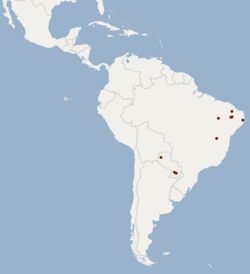| Myotis lavali | |
|---|---|
| Scientific classification | |
| Kingdom: | Animalia |
| Phylum: | Chordata |
| Class: | Mammalia |
| Order: | Chiroptera |
| Family: | Vespertilionidae |
| Genus: | Myotis |
| Species: | M. lavali |
| Binomial name | |
| Myotis lavali Moratelli, Peracchi, Dias & de Oliveira, 2011 | |
 | |
| Distribution of Myotis lavali | |
LaVal's myotis (Myotis lavali) is a species of bat found in Brazil and Paraguay. [1] [2]
